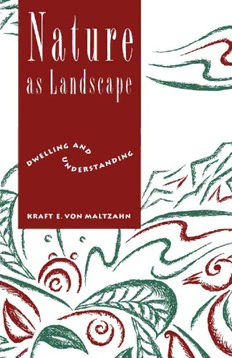
Nature As Landscape: Dwelling and Understanding PDF
Preview Nature As Landscape: Dwelling and Understanding
NA TURE AS LANDSCAPE Dwelling and Understanding Human interaction with the natural world has created serious environ- mental problems. In Nature as Landscape Kraft von Maltzahn examines the "unnatural" relationship that has developed between human beings and nature. Drawing on evidence from philosophy and the history of sci- ence, he argues that humans have become estranged from nature and shows how this estrangement has evolved. Von Maltzahn focuses on how we experience aspects of nature in terms of their outer appearance, such as landscape, and contends that the naturalistic scientific tradition has taught us to divorce ourselves from the natural world, to become impartial observers rather than partici- pants. He examines the nature of the human life-world and describes the process of self-deception that has led to the contemporary dismissal of that life-world as merely subjective. Drawing on phenomenology, semi- otics, visual thinking, gestalt psychology, and Polanyi's arguments about tacit knowing, he offers an alternative way of perceiving the natural world that would reunite humans and nature. Given the current state of the global environment, it is crucial that the debate on the relationship of human beings and nature take place on many levels. Given the failure of conventional approaches to conserva- tion, developing alternative ways of understanding human relations has become critically important. KRAFT E. VON MALTZAHN is professor emeritus of biology, Dalhousie University and University of King's College. K.H. Steib, Nach der Ernte, 1976 (Kraft von Maltzahn, Halifax, Nova Scotia) Nature as Landscape Dwelling and Understanding KRAFT E. VON MALTZAHN McGill-Queen's University Press Montreal & Kingston • London • Buffalo McGill-Queen's University Press 1994 ISBN 0-7735-1233-0 Legal deposit third quarter 1994 Bibliotheque nationale du Quebec Printed in Canada on acid-free paper This book has been published with the help of a grant from the Social Science Federation of Canada, using funds provided by the Social Sciences and Humanities Research Council of Canada. Funds have also been received from Dalhousie University and from the Canada Council through its block grant program. Canadian Cataloguing in Publication Data Von Maltzahn, Kraft E. (Kraft Eberhard), 1925- Nature as landscape: dwelling and understanding Includes bibliographical references and index. ISBN 0-7735-1233-0 i. Human ecology - Philosophy. I. Title. GF9o.v65 1994 304.2 094-900343-3 This book was typeset by Typo Litho Composition Inc. in 11/13 Adobe Garamond. Contents Figures vii Preface ix Introduction 3 1 The Objective Interpretation of Nature 7 2 Human Beings and Nature in the Mythological World 19 3 The Interpretation of Humankind 27 4 The Historical Nature of Humankind and the Contemporary Technological Order 36 5 Nature and Culture, i 44 6 The Biological World 53 7 The Life-World, i 66 8 The Life-World, 2 77 9 Visual Thinking and Tacit Knowing 84 10 Nature and Culture, 2 96 11 Nature as Landscape 109 12 Construction of a World 118 Conclusion 126 Notes 131 Index 145 This page intentionally left blank Figures 1 Situation Circle 50 2 Functional Circle 55 3 S. Haase, Landscape 75 4 Meindert Hobbema, The Road to Middelharnis, 1689 102 5 William Turner, Rain, Steam and Speed, 1843 104 6 Georges Braque, Maisom a L'Estaque, 1908 106 This page intentionally left blank Preface The thesis presented in this work arose out of a conflict concerning our own position in relation to nature. We were taught to be impartial ob- servers of nature in order to gain objective knowledge of the natural world. But we became aware that we cannot be impartial observers of na- ture, because all our experience is necessarily intentional. Knowing is not an exercise in impartiality, but knowing and being are intricately linked in our everyday life-world. In my attempt to resolve some of the conflict between the scientific attitude and a view of science as only one aspect of the life-world, I have been helped by students and masters alike. Professor A. Frey-Wyssling of the Eidgenossische Technische Hochschule in Zurich, Switzerland, shared his wide range of skilful knowledge with his students, introducing us not only to alpine plants and the landscapes containing them, but also to the submicroscopic morphology of protoplasm. Professor E.W. Sinnott of Yale University in Connecticut encouraged me during my doctoral studies to view even the most specialized problem in the broad- est context. I thank my colleagues Cheryl Knight and Dr Pat Lane for helping me in the early stages of the manuscript, and especially my wife Anne for clarifying my written expression. Pat Dixon patiently and cheerfully typed each version of my manuscript. Dr Warwick Kimmins, dean of science at Dalhousie University, enabled me to obtain financial assis- tance for publication of my work. I am grateful to my publishers, espe-
